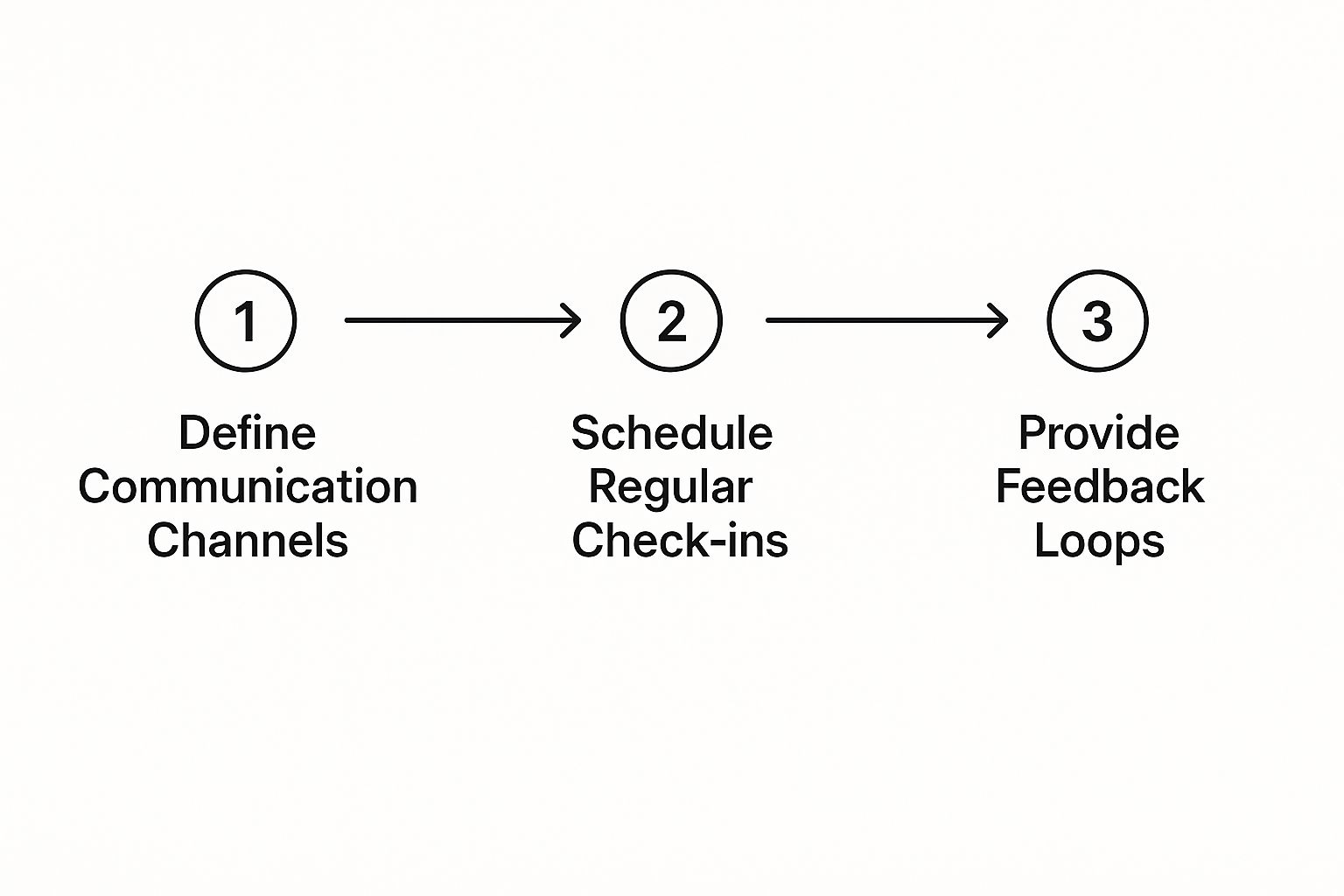Here’s the thing about working with freelancers: it all comes down to a pretty simple formula. You need clear communication, well-defined expectations, and most importantly, you have to treat them like true partners.
Nail this process, and you’ll find yourself tapping into specialized skills on demand, pushing projects forward faster, and building a flexible, agile team—all without the traditional overhead.
Why Freelancers Are Your Secret Weapon
Bringing freelancers into your business isn't just about managing overflow work or trimming the budget. It's a real strategy for growth and staying ahead of the curve. Today's world demands speed and specialization, and a flexible workforce is exactly how you meet those demands.

And this isn't just a tactic for small startups anymore. The global freelance market is on track to hit a staggering $455.2 billion by 2025. Think about that. Even the big players are all in—as of 2022, over 48% of Fortune 500 companies were using freelance platforms to get work done. This massive shift shows how top businesses are learning to work with freelancers to stay nimble.
The Real Perks Go Way Beyond Cost Savings
Sure, being efficient with your budget is a nice bonus, but the real magic of freelancers is their ability to bring specific, high-level skills into your team at the exact moment you need them. I like to think of it as plugging into a "talent cloud."
- Access to Niche Experts: Need a Webflow developer who knows the ins and outs of e-commerce integrations? Or a copywriter who lives and breathes SaaS? You can hire a specialist for one project without the commitment of a full-time salary.
- Move Faster and Get More Done: A small marketing team can instantly expand for a big product launch by bringing on a freelance social media manager and a video editor. Suddenly, they're executing complex campaigns in weeks, not months.
- Stay Flexible: Freelancers give you an elastic resource. You aren't saddled with fixed payroll costs during a slow quarter. Then, when a new opportunity pops up, you can spin up a team almost overnight. It's worth understanding concepts like the staff augmentation model to see just how much strategic flexibility this can offer.
A New Way of Thinking About Teamwork
To really succeed with freelancers, you have to ditch the old-school employer-employee mindset. This relationship is more of a partnership between two independent businesses. Your freelancer isn't just a temp; they're a specialist consultant.
I’ve found the best collaborations happen when you treat freelancers like they’re part of the team. Give them the context, tools, and trust they need to do their best work, and you’ll be blown away by the results.
By building a solid process for finding, onboarding, and managing freelance talent, you're creating a powerful, scalable extension of your core team. This isn't just outsourcing work. It's strategic team-building for the way business works now. This guide will walk you through exactly how to get it right.
Alright, let's get into the first, and arguably most important, step in bringing a freelancer onto your team: defining exactly what you need and getting it all down on paper.
How to Define Your Needs and Craft the Perfect Brief
Jumping into hiring without a crystal-clear plan is like trying to build a house without a blueprint. You might end up with something, but it's not going to be the sturdy, beautiful home you envisioned. Before you even start browsing freelancer profiles on Creativize, your number one job is to get brutally honest about what you're trying to achieve.

This part is absolutely non-negotiable.
I’ve seen it a hundred times: a vague request like "I need a new logo" goes out, and what comes back is a flood of equally vague proposals. It's a recipe for endless back-and-forth, frustration, and a final product that misses the mark. Contrast that with a detailed request, and you get sharp, accurate quotes from pros who get it from the get-go.
From Hazy Idea to Actionable Plan
The real goal here is to take that idea swirling around in your head and translate it into a document that leaves zero room for guessing games. This document, the project brief, becomes your single source of truth for the entire project. It's what saves you from scope creep and ensures the freelancer delivers exactly what you paid for.
Let's look at a real-world example of turning a fuzzy request into a powerful one:
- The Vague Idea: "I need someone to write a blog post."
- The Actionable Plan: "I'm looking for a 1,500-word, SEO-optimized article on 'Best Project Management Tools for Small Agencies.' The piece needs to target agency owners, include quotes from two industry experts, and is intended to rank for the primary keyword within three months to drive sign-ups for our product demo."
See the difference? The second version tells a freelancer everything they need to know: the scope, the audience, the business goal (KPIs), and the specific deliverables. This level of detail is a magnet for serious professionals and a filter for everyone else.
What Goes Into a Killer Project Brief?
A truly great brief gives a freelancer both the "what" and the "why." It’s not just a to-do list; it’s the context they need to make smart, strategic decisions on your behalf. If you want to go even deeper, our guide on https://creativize.net/blog/how-to-write-a-creative-brief is a fantastic resource for this.
To help you get started, we've broken down the must-have elements for any brief you create in this table.
Essential Components of a High-Impact Project Brief
This table summarizes the key ingredients of a project brief that will not only attract top talent but also set your project up for success from day one.
| Component | What to Include | Why It Matters |
|---|---|---|
| Company & Project Background | A quick summary of who you are, what your business does, and the main goal of this project. | It helps the freelancer understand how their specific task fits into your bigger business picture. Context is king. |
| Target Audience | A detailed description of your ideal customer. Think demographics, their biggest challenges, and what motivates them. | You can't create work that resonates if you don't know who you're talking to. This is crucial for effective results. |
| Specific Deliverables | An exact list of what you expect to receive. Be super specific, like "Home, About, and Services page copy." | This avoids the dreaded "I thought you were going to…" conversation. It protects both you and the freelancer. |
| Timeline & Key Milestones | The final deadline, plus any important check-in dates for things like first drafts, wireframes, or mockups. | It keeps the project on track and ensures everyone is aligned on timing. It prevents last-minute scrambles. |
| Budget | Be upfront about what you can spend. You can provide a range or a fixed price. | This saves everyone a ton of time. You’ll only get proposals from freelancers who can work within your budget. |
Think of your brief as more than just an instruction manual. When done right, it actively sells your project to the best freelancers out there.
A well-crafted brief doesn't just outline tasks; it shows top-tier talent that you're an organized, professional client worth working with. Freelancers are business owners, too—they gravitate toward clarity and clients who respect their process.
Putting It All Together: Real-World Examples
To make this feel less abstract, let's see what this looks like for a couple of common projects.
For a Social Media Management Project:
- Objective: Boost our Instagram engagement by 15% over the next 90 days.
- Deliverables: Plan and schedule 12 feed posts, 30 Stories, and 4 Reels each month. Deliver a monthly analytics report highlighting what worked and what didn't.
- Audience: Tech-savvy entrepreneurs, 25-40 years old, who follow people like Gary Vaynerchuk and listen to business podcasts.
- Mandatories: All posts must follow our attached brand style guide and use our approved list of hashtags.
For a Brand Identity Project:
- Objective: Create a new brand identity that positions us as a premium, eco-friendly choice in the home goods space.
- Deliverables: A primary logo, secondary logo versions, a defined color palette, typography guidelines, and a simple one-page brand style guide.
- Audience: Environmentally conscious millennials with a household income north of $100,000.
- Inspiration: We love the clean, trustworthy vibe of brands like Patagonia and Allbirds.
For more specialized projects, leaning on a template can be a lifesaver. If you're hiring for influencer marketing, for example, using a structured influencer brief template ensures you cover everything from campaign goals to FTC disclosure rules.
Putting in this work upfront is easily the single best investment you can make for a smooth and successful freelance partnership.
Alright, you’ve got your project brief polished and ready to go. You've done the foundational work. Now for the fun part: finding the perfect creative partner to bring that vision to life.
This is where the real magic happens, moving beyond simply posting a job and into the art of recruiting a true collaborator.

Let’s be honest, the way we find talent has completely changed. You're no longer stuck with just local contacts or hoping for a good word-of-mouth referral. The freelance economy has exploded, especially in the U.S., where it rocketed up by 90% between 2020 and 2024.
This isn't just a trend; it's the new reality. Freelancers are a core part of the modern workforce, and some experts predict they'll make up more than half of the entire U.S. labor force by 2027. Platforms like Creativize are at the heart of this shift, connecting businesses with a global talent pool for just about any niche task you can think of—like web design, which accounts for 36% of all freelance business hires.
Where To Look For Top-Tier Freelancers
Your hunt for the right person can go down a few different paths. I’ve found that mixing and matching these approaches usually gets the best results.
- Freelance Platforms (Like Creativize): This is your most efficient first stop. You get instant access to a massive, searchable database of professionals. You can filter by skills, location, and experience level, then immediately dive into portfolios and client feedback. It’s a structured way to simplify the whole search-and-hire dance.
- Niche Job Boards: If you’re hiring for a really specific role, don’t sleep on industry job boards. Think design-centric communities for a branding pro or technical writing hubs for a documentation specialist. The talent pool is smaller, but it’s often much more targeted.
- Your Own Professional Network: Seriously, never underestimate the power of a good referral. When a colleague you trust recommends someone, that’s a built-in layer of vetting right there. Post on LinkedIn. Ask other business owners in your circle. You’d be surprised who people know.
How To Actually Analyze A Freelancer’s Portfolio
A portfolio isn’t just a pretty gallery of past projects. It’s a direct look into a freelancer’s skills, their style, and how they solve problems. Don't just give it a quick skim. You need to dig in to see if their talent truly lines up with what your project demands.
Here’s what I ask myself when I'm reviewing a portfolio:
- Is this work even relevant to my project? A graphic designer might have a killer portfolio full of print ads, but if you need a UI/UX expert for a mobile app, that experience might not translate. Look for hard evidence that they’ve nailed projects similar to yours. Our guide on hiring a freelance graphic designer has more on this.
- Does their style vibe with my brand? Look for consistency. Do they have a clear aesthetic or point of view? A freelancer who can seamlessly adapt to different brand voices is worth their weight in gold.
- What’s the story behind the work? The best portfolios don’t just show you the shiny end result; they walk you through the how and why. I always look for case studies that break down the client’s initial problem, the freelancer's strategy, and the results they delivered. That shows strategic thinking, not just button-pushing.
What Client Reviews Are Really Telling You
Reviews are your secret window into what it’s actually like to work with someone. A five-star rating is nice, but the story behind it is what counts.
Don't just look at the ratings; read the stories behind them. A review that says, "They were a great communicator and delivered ahead of schedule" is far more telling than a generic "Good job."
Look for patterns. Do multiple clients rave about the freelancer’s communication, their reliability, or their ability to take feedback? Those soft skills are often just as crucial as the technical ones. On the flip side, if you see recurring negative comments, that’s a potential red flag you shouldn't ignore.
The 15-Minute Chemistry Check
Once you've got a shortlist of promising candidates, a quick video call is the final hurdle. This isn’t some stuffy, formal interview. Think of it as a chemistry check to make sure you’ll work well together.
Keep it short and sweet—15 to 20 minutes is plenty. Here are a few questions I like to ask to get the conversation rolling:
- "Based on the brief, what's your initial take on how you'd approach this?"
- "Can you walk me through a similar project and what the outcome was?"
- "How do you like to communicate and get feedback while a project is in motion?"
- "What questions do you have for me about the project or my expectations?"
This chat is your chance to get a feel for their communication style, professionalism, and whether they seem genuinely excited about your project. The goal isn’t to find the cheapest person, but the partner who delivers the most value through a mix of skill, reliability, and collaboration.
How to Master Freelancer Onboarding
You've found the perfect freelancer. Contract signed. Awesome. But the moment you finalize the hire, the real work begins.
Too many businesses drop the ball right here. They fire off a quick welcome email and think the job is done. A rushed, unstructured start is the number one reason promising freelance partnerships fizzle out before they even get going.
Let’s be real: a smooth, intentional onboarding process isn't just a "nice-to-have." It’s the very foundation of a great collaboration.
Think about it. You'd never hire a full-time employee, point them to an empty desk, and just walk away. No computer, no logins, no intros. You’d have a plan. Give freelancers that same respect. It sets the tone, makes expectations crystal clear, and gives them the tools to start delivering amazing work from day one.
Set Up Your Communication Command Center
First things first: decide how you're going to talk. Email chains are where good projects go to die—a tangled mess of lost files and missed messages. Don't do it.
Instead, create a dedicated space for the project.
For most of us, that means a dedicated Slack channel. Invite your new freelancer and any internal team members who are involved. This keeps every conversation, file share, and quick question in one place. It builds transparency and stops your freelancer from feeling like they're working in a silo.
Now’s also the time to grant access to everything they'll need.
- Project Management: Add them to your Trello, Asana, or Jira board.
- File Storage: Give them permissions for the right Google Drive or Dropbox folder.
- Brand Assets: Share the link to your style guide, logos, fonts, and any other brand docs.
- Software: Make sure they have the licenses or logins for any required software.
Giving them everything upfront prevents those frustrating "Hey, can you add me to this?" delays. The goal is to remove friction, not create it.
The All-Important Kickoff Call
Once they have all their access sorted, the kickoff call is your single most critical onboarding step. This isn't just a formality; it's a strategy session. It’s your chance to move beyond the written brief and build an actual human connection.
Honestly, one good kickoff call can save you weeks of misunderstandings down the line.
A kickoff call transforms a freelancer from a name on a contract into a real collaborative partner. It's where you align on the unspoken stuff and build the trust you need for honest feedback and creative problem-solving.
Your agenda for this call should hit three key areas:
- Reconfirm Goals & Deliverables: Don't just assume they read the brief. Walk through it together. This is your moment to clear up any gray areas. Ask questions like, "Based on the brief, what's your take on the main goal here?"
- Define the Workflow: Talk about how you'll work together. How often will you check in? How will feedback be delivered? What does the approval process look like? This prevents a total mismatch in communication styles.
- Build a Relationship: Ask about their working style. Let them know who their go-to person is. Make it a two-way conversation, not a lecture.
Great communication isn't something you do once; it's a process you build from the very start. This is the core loop that keeps projects on track.

This cycle shows that clear communication is continuous—it’s all about connection, updates, and constructive input.
Handling the Paperwork and Payments
With the project details ironed out, it’s time to get the business side of things locked in. Never, ever leave contracts and payment terms to a verbal agreement. It's not about mistrust; it's about being professional and protecting both of you.
Your contract needs to clearly spell out:
- The full scope of work and all deliverables.
- Project timelines and key milestones.
- Payment terms, including rates, currency, and the invoicing schedule.
- Clauses for intellectual property ownership and confidentiality.
Getting the payment process sorted upfront saves so many awkward conversations later. Will you pay when you get the invoice? On a net-30 schedule? Is it a fixed project fee paid out in chunks?
On the Creativize platform, these terms are built right into the project agreement, giving everyone clarity and security.
Putting in the effort to build a solid onboarding process pays off every single time. For more ideas, our new client onboarding checklist and template is a huge help for structuring this.
Effective Communication and Project Management
Once your freelancer is on board, the real work begins. This is where a project either takes off or falls apart, and it almost always comes down to communication and management. Let's be clear: working with freelancers effectively means dropping the micromanagement and embracing structured, respectful oversight.
Remember, you're managing the project, not the person. Freelancers are independent pros. Your job is to set a clear direction, get obstacles out of their way, and keep the feedback flowing so they can deliver their best work.
Setting a Rhythm for Check-ins
One of the biggest mistakes I see is clients either spamming a freelancer with "just checking in" pings or going completely dark for weeks. Neither works. You need to find the right cadence, and it really depends on the project.
- For quick, simple tasks (like a single blog post), a kickoff call and a check-in before the deadline might be all you need.
- For projects spanning a few weeks (like website copywriting), a weekly 15-minute sync is perfect. It keeps everyone on the same page without becoming a chore.
- For complex, long-term work (like app development), I've found that daily or bi-weekly async updates in Slack, paired with a weekly call, is the sweet spot.
The whole point is to establish a predictable rhythm. This gives the freelancer the space they need to work while giving you enough visibility to catch any issues before they snowball.
Manage the project, not the person. Your role is to provide clear goals and systems for tracking progress, then trust the professional you hired to execute. This approach fosters respect and empowers freelancers to take ownership.
The Art of Giving Feedback That Actually Helps
Giving feedback is a skill, and it’s one of the most critical parts of working with freelancers. Vague, subjective comments are just frustrating. Actionable, specific feedback? That's a gift that gets you better results, faster.
Let’s look at a real-world example. A freelancer sends you the first draft for a new landing page.
Bad Feedback (Vague and Unhelpful):
"I don't really like this. The tone feels off, and it's not very exciting. Can you try again?"
This leaves the freelancer totally in the dark. What does "off" even mean? What's your definition of "exciting"?
Good Feedback (Specific and Actionable):
"This is a great start! In the headline, let's try to focus more on the 'time-saving' benefit we discussed. Also, in the second section, can you replace the general stats with the customer testimonial I shared in the brief? I feel that would make it more impactful."
See the difference? The second example points to specific spots, offers clear suggestions, and ties everything back to the project goals. It empowers the freelancer to make precise, effective changes. For a deeper dive, check out our guide on client communication best practices.
Choosing Your Collaboration Tech Stack
Good communication runs on good tools. If you’re just relying on email, you’re asking for lost files and missed messages. A simple, central tech stack keeps everyone in sync.
Here are the essentials:
- Project Management: Tools like Trello, Asana, or ClickUp are non-negotiable for visualizing tasks, tracking progress, and setting deadlines. They create a single source of truth.
- Communication: A dedicated Slack channel is perfect for those quick questions and daily updates that would otherwise clog up your inbox.
- File Sharing: Use Google Drive or Dropbox to keep all your documents, briefs, and brand assets in one place. No more "which version is the latest?" headaches.
This way of working isn't just a trend; it's the new standard. In fact, nearly half (46.5%) of the global workforce is self-employed, which includes a massive pool of freelancers. To really streamline your operations, it’s worth exploring the best contractor management software for global teams to handle everything from payments to project oversight.
When you nail down a clear communication rhythm, master the art of feedback, and use the right tools, you're not just completing a project. You're building a partnership based on clarity and mutual respect—and that’s how one-off gigs turn into successful, long-term relationships.
Common Questions About Working With Freelancers
Jumping into the world of freelance collaboration can bring up a lot of "what ifs" that go way beyond project briefs and management styles. I've seen it time and again—getting these practical details sorted out upfront is the secret to building smooth, professional relationships that last.
Let's tackle some of the most common questions and concerns businesses have when they start working with freelancers. Things like payments, contracts, and team dynamics might seem complicated, but I promise they're pretty straightforward once you have a game plan.
How Do You Handle Payments and Contracts With International Freelancers?
Tapping into a global talent pool is one of the best parts of building a flexible team, but it does mean you need a rock-solid process for payments and legal stuff. The key? Total clarity from day one.
A detailed freelance contract is completely non-negotiable. Don't even think about starting without one. It's your safety net and theirs.
It absolutely must spell out:
- Payment Terms: The exact project rate, the currency (e.g., USD, EUR), and the payment schedule. No ambiguity.
- Payment Method: How are you going to send the money? Agree on this before any work is done.
- Deliverables and Deadlines: Tie payments directly to specific project milestones. This keeps everyone motivated and on the same page.
Honestly, using a platform like Creativize makes this so much easier. Our system is built to handle international payments and comes with standard contract templates that take the guesswork out of it. This protects both you and the freelancer. Milestone-based payments, where you release funds after approving specific deliverables, are a fantastic way to keep projects on track and ensure everyone feels secure.
What Is the Best Way to Integrate a Freelancer Into an Existing Team?
If you really want to get the most out of a freelancer, you have to treat them like a real (though temporary) part of the team. Walling them off in a silo is a recipe for disconnect and seriously limits their ability to do their best work. True integration is all about creating a sense of shared purpose.
Start small. Introduce them to the core people they'll be working with. A quick "Hey everyone, let's welcome [Name] to the team!" in your company's main chat channel can make a world of difference.
"The goal isn't just to hand off tasks; it's to build a collaborative space. When a freelancer feels like they're actually on the team, they get more invested in the project's success and are way more likely to jump in and solve problems proactively."
Give them access to the right communication channels, like a dedicated Slack room for the project. Invite them to important meetings—not all of them, just the ones where their input would be genuinely valuable. Clearly defining their role and how it slots in with your full-time employees' work clears up confusion before it even starts.
How Do You Manage Intellectual Property and Confidentiality?
This is a big one. You need to protect your company's sensitive info and make sure you own the final work product. This is all handled through clear, legally sound agreements that are signed before a single minute of work begins.
Your freelance contract needs two crucial clauses:
- A Non-Disclosure Agreement (NDA): This is the legal handshake that binds the freelancer to keep any confidential information they see completely private.
- An Intellectual Property (IP) Assignment Clause: This part should state, in no uncertain terms, that once the final payment is made, all rights and ownership of the work created for the project transfer over to your company.
When it comes to sharing sensitive files, always use secure systems with permission controls, like Google Drive or Dropbox. Only give them access to the specific files and folders they absolutely need. This mix of legal paperwork and practical security measures keeps your IP and confidential info locked down.
Taking these steps also shows freelancers you're a professional operation, which helps them understand how to build their own reputation and learn how to get freelance clients by working with great partners like you.
Ready to connect with top-tier creative talent and build your flexible team? Creativize makes it simple to find, hire, and manage vetted professionals for any project. Find your perfect creative partner today at https://creativize.net.

